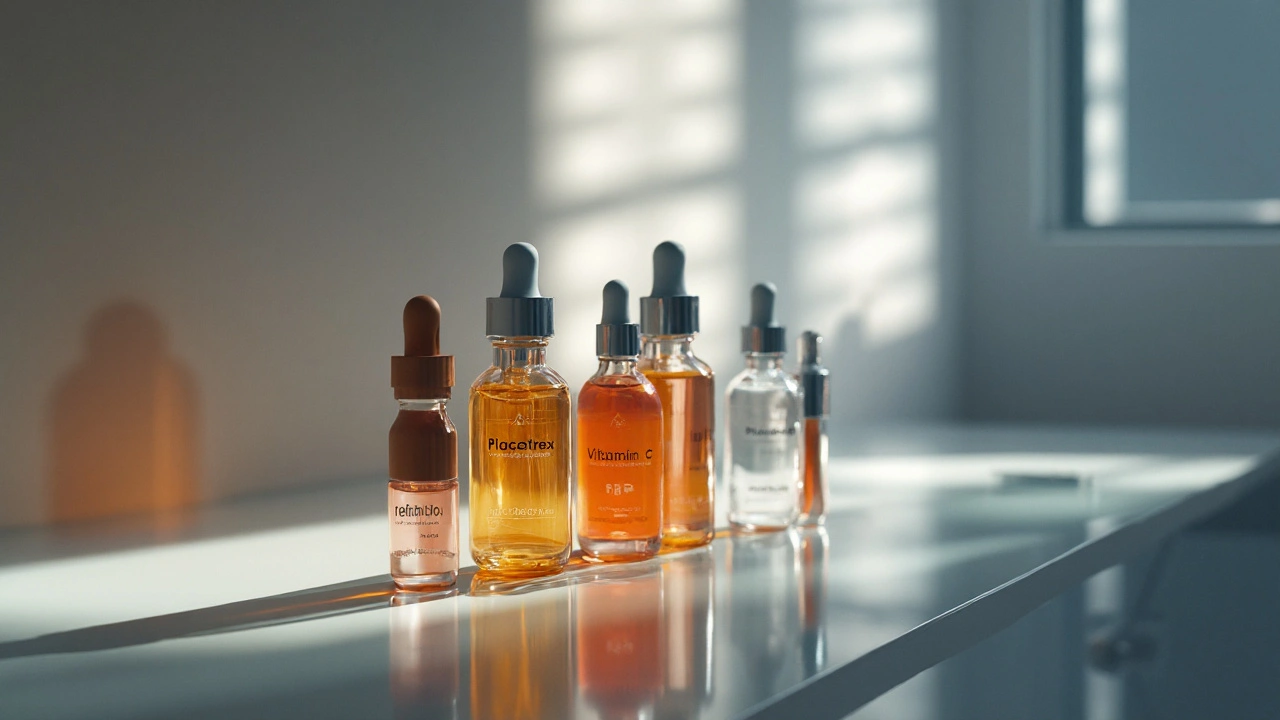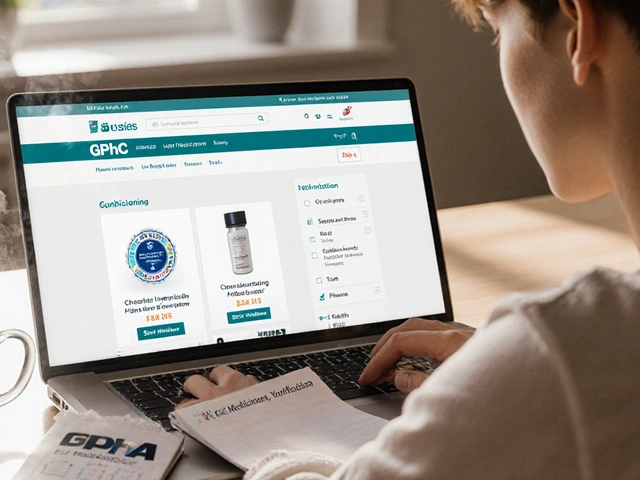Skin Care Choice Quiz
Placentrex is a human placental extract formulation preserved with nitrogen gas, marketed for skin regeneration and anti‑aging. If you’ve ever scanned a beauty shelf and wondered whether this mysterious serum is worth the hype, you’re not alone. The rise of bio‑active cosmetics has created a maze of claims, and figuring out if Placentrex truly delivers-or if a more familiar ingredient might serve you better-requires a clear comparison.
What is Placentrex?
The core of Placentrex is Human Placental Extract (often abbreviated HPE). This extract is harvested from donated placental tissue, filtered, and then combined with Nitrogen to keep the mixture stable and free from oxidation. HPE is rich in collagen precursors, hyaluronic‑like polysaccharides, and a cocktail of growth factors such as epidermal growth factor (EGF) and transforming growth factor‑beta (TGF‑β). Those molecules are the same ones your skin produces naturally during wound healing, which is why manufacturers claim Placentrex can boost elasticity, reduce fine lines, and accelerate tissue repair.
How Placentrex Works on the Skin
When applied, the growth factors signal dermal fibroblasts to ramp up collagen synthesis. In practical terms, fibroblasts lay down new collagen fibers, which thickens the dermal matrix and smooths out wrinkles. The hyaluronic‑like components draw water into the epidermis, giving a temporary plump look. Clinical reports from Asian dermatology clinics-where Placentrex first gained popularity-show average reduction of wrinkle depth by 12‑15% after eight weeks of twice‑daily use. However, most of these studies involve small sample sizes and lack double‑blind controls, a point worth noting when you weigh the evidence.
Safety, Regulation and Ethical Concerns
Because Placentrex is derived from human tissue, it falls under a different regulatory umbrella than synthetic actives. In the UK, the Medicines and Healthcare products Regulatory Agency (MHRA) classifies it as a “cosmetic medical device” when marketed for cosmetic purposes, meaning it does not require a prescription but must meet strict hygiene and sourcing standards. The use of donated placenta raises ethical questions; reputable manufacturers must verify donor consent and follow Good Manufacturing Practice (GMP). A few adverse‑event reports mention mild erythema or transient itching, typically resolving within 24 hours. People with known allergies to human proteins should patch‑test before committing to a full‑face routine.
Popular Alternatives on the Market
While Placentrex promises a bio‑based boost, a handful of well‑studied ingredients compete for the same anti‑aging territory. Below are the most common contenders:
- Retinol (Vitamin A derivative) - stimulates cell turnover and collagen production; gold standard for decades.
- Vitamin C - antioxidant that stabilises collagen and brightens hyperpigmentation.
- Hyaluronic Acid - a humectant that retains up to 1,000 times its weight in water, delivering immediate plumpness.
- Platelet‑rich plasma (PRP) - autologous blood concentrate injected or microneedled into skin; high concentration of growth factors similar to HPE.
- Stem Cell Extracts (typically plant‑based) - claim to mimic cellular rejuvenation pathways.
Side‑by‑Side Comparison
| Product | Primary Active(s) | Main Action | Typical Form | Cost (UK, per 30ml) | Evidence Level |
|---|---|---|---|---|---|
| Placentrex | Human Placental Extract, Nitrogen | Growth‑factor‑driven collagen boost, hydration | Serum / cream | £45‑£55 | Small clinical trials, case series |
| Retinol | Retinol (Vitamin A) | Cell turnover acceleration, collagen synthesis | Cream, serum | £30‑£40 | Large RCTs, meta‑analyses |
| VitaminC | L‑Ascorbic Acid | Antioxidant protection, collagen stabilisation | Serum | £25‑£35 | Moderate RCTs |
| Hyaluronic Acid | HA polymer | Surface hydration, barrier reinforcement | Gel, serum | £20‑£30 | Extensive safety data, limited long‑term studies |
| PRP | Autologous platelet‑derived growth factors | Intense collagen remodelling, tissue regeneration | In‑office injection or microneedling | £250‑£350 (single session) | Variable; promising but heterogenous trials |

When Might Placentrex Be the Right Choice?
If you prefer a topical that mimics the body's own healing cocktail without needing a prescription or a clinic visit, Placentrex offers a middle ground between simple moisturisers and invasive procedures. It suits people with sensitive skin who react to retinoids, because the growth‑factor blend tends to be gentler. For those chasing a quick “hydrated glow” alongside modest wrinkle reduction, the serum version works well when paired with a basic sunscreen routine.
Scenarios Where Alternatives Shine
Retinol remains unbeatable for deep‑line reduction when used consistently for six months or more. VitaminC tops the list for brightening and protecting against UV‑induced damage. Hyaluronic Acid delivers immediate plumpness without any irritation risk, making it ideal for daily use under makeup. PRP is the go‑to for severe laxity or post‑procedural recovery, though the cost and need for professional administration limit its accessibility. Stem‑cell extracts appeal to vegans or those avoiding animal‑derived ingredients, though scientific backing is still emerging.
Practical Tips for Integrating Any of These Actives
- Start with a patch test: apply a small amount on the jawline for 48hours.
- Introduce one new product at a time; give the skin at least two weeks to adapt.
- Always follow with a broad‑spectrum SPF30+ in the morning; growth factors and retinoids alike can increase photosensitivity.
- Layer from thinnest to thickest texture-serum (Placentrex, VitaminC) → gel/cream (HA) → occlusive moisturiser.
- Monitor results with simple photography; note changes in texture, fine line depth, and overall tone.
Cost‑Benefit Summary
From a budget perspective, placing Placentrex alongside a retinol or VitaminC serum puts it in a slightly higher price bracket, but still far less than periodic PRP clinics. If you’re after a single product that offers both hydration and a subtle collagen push, the extra £10‑£15 per month can be justified. However, if deep‑seated wrinkles are your primary concern, investing in a proven retinol regimen may deliver faster, more measurable results.
Next Steps for Readers
Identify your skin goals-whether it’s firmness, brightness, or minimal irritation. Match those goals to the evidence tier shown in the table. If Placentrex aligns with your needs and you appreciate its bio‑derived story, look for UK‑licensed suppliers that disclose donor screening procedures. For those leaning toward alternatives, start with a low‑strength retinol or a stable VitaminC serum and track progress for at least three months before deciding if an upgrade is necessary.
Frequently Asked Questions
Is Placentrex safe for daily use?
In most dermatology studies, participants applied the serum twice daily without severe irritation. Mild redness can occur, especially on very sensitive skin, so a patch test is advisable before full‑face use.
How does Placentrex differ from PRP?
Both contain growth factors, but PRP is derived from the patient’s own blood and administered via injection or microneedling, requiring a clinic visit. Placentrex is a topical, off‑the‑shelf product that uses placental tissue as the source, making it more convenient but generally less potent.
Can I combine Placentrex with retinol?
Yes, but stagger the applications. Use retinol at night and Placentrex in the morning, or alternate days, to minimise potential irritation and preserve the efficacy of both actives.
What ethical concerns exist around placental extracts?
Reputable brands must obtain informed consent from donors and follow GMP standards. Look for certifications that confirm the placenta was sourced from screened, healthy donors and that the extraction process meets UK regulatory guidelines.
Is there any scientific consensus on Placentrex’s effectiveness?
Current literature consists mainly of small open‑label studies and case series, mostly from East Asian clinics. While results are promising, larger, double‑blind trials are needed before the product can be universally endorsed.





Alex V
September 24, 2025 AT 22:55Picture this: a bottle of Placentrex sitting on your vanity, promising the secrets of the womb to your epidermis. The idea alone feels like a plot twist straight out of a sci‑fi thriller, doesn’t it? Yet the science behind human placental extract is… well, a tangled web of growth factors, polysaccharides, and a dash of corporate hype. If you’re the type who reads the fine print like it’s a secret diary, you’ll notice the studies are small, often lacking proper blinding, and hail mostly from East Asian clinics. That’s not to say the serum has no merit; the hyaluronic‑like molecules do pull water into the skin, giving that fleeting “just‑came‑out‑of‑the‑spa” glow.
Robert Jackson
September 27, 2025 AT 05:26i cant even with the womh drama, but if it works its a win.
Maricia Harris
September 29, 2025 AT 11:53Hold the phone! I swear I tried Placentrex for a month and my skin went from a desert to a rainforest overnight. The moment I opened the jar, I could practically hear a choir of angels humming. By day three, the fine lines started to look like they were on a bad reality TV show – totally out of focus. Seriously, if you’ve ever wanted to feel like you’ve been kissed by a newborn baby (the good kind, not the crying kind), this is the potion. Just beware of the occasional red flare‑up; it’s like your skin throwing a tiny tantrum, but it’s totally worth the drama.
Tara Timlin
October 1, 2025 AT 18:20If you decide to add Placentrex to your routine, start with a patch test on the jawline for 48 hours. Once tolerated, apply a pea‑sized amount in the evening after cleansing and before heavier moisturisers. Layer from thinnest to thickest: serum first, then a hyaluronic‑acid gel if you need extra plumpness, and finish with a barrier‑repair cream. Remember to follow with a broad‑spectrum SPF30+ each morning, as growth factors can modestly increase photosensitivity. Keep a simple journal with photos every two weeks to track any changes in fine‑line depth or overall texture.
Jean-Sébastien Dufresne
October 4, 2025 AT 00:46Wow!! 🎉 Your step‑by‑step guide is practically a skincare bible!!! 👍 Just a heads‑up: don’t forget to store the serum in the fridge if you live in a warm climate – it helps preserve the bio‑actives longer!!! 😊
Patrick Nguyen
October 6, 2025 AT 07:13Placentrex offers modest hydration; for sensitive skin it may be gentler than retinol.
Patrick Bread
October 8, 2025 AT 13:40One might assume that a serum derived from placental tissue automatically eclipses all known actives, yet the data tells a quieter story.
Fiona Doherty
October 10, 2025 AT 20:06Listen up, if you can't tolerate a pea‑sized amount of retinol, Placentrex is the only sensible fallback.
Neil Greer
October 13, 2025 AT 02:33Hey folks, just a quick heads‑up-make sure you store the bottle in a cool, dark place to maintain stability.
Fionnuala O'Connor
October 15, 2025 AT 09:00Keep it simple don't overthink it.
Christopher MORRISSEY
October 17, 2025 AT 15:26When evaluating Placentrex, it is essential to first acknowledge the biochemical premise: the extract contains epidermal growth factor, transforming growth factor‑beta, and a suite of glycosaminoglycans that collectively aim to mimic the skin’s innate repair mechanisms. Theoretically, these molecules should stimulate fibroblast proliferation, enhance collagen synthesis, and improve extracellular matrix organization. In practice, however, the magnitude of these effects hinges on the concentration of active peptides that survive the extraction and stabilization processes. Existing clinical data, primarily from East Asian dermatology practices, report an average 12‑15 % reduction in wrinkle depth after eight weeks of twice‑daily application. While these numbers are promising, the studies suffer from modest sample sizes and a lack of double‑blind controls, which limits the generalizability of the findings. Moreover, the proprietary nature of the extraction method restricts independent verification of ingredient purity and activity. From a safety perspective, reported adverse events are limited to mild erythema and transient itching, typically resolving within 24 hours, suggesting a favorable tolerance profile for most skin types. Nonetheless, individuals with known hypersensitivity to human proteins should conduct a patch test before full‑face use. Cost considerations also play a role; at £45‑£55 per 30 ml, Placentrex sits between conventional retinol serums and high‑end in‑office procedures such as PRP. For consumers on a tighter budget, a well‑formulated retinol or vitamin C serum may deliver comparable-or in the case of retinol-superior anti‑wrinkle benefits backed by robust randomized controlled trials. Conversely, for those seeking a gentle, growth‑factor‑centric approach without the invasiveness of PRP, Placentrex presents a viable middle ground. Ultimately, the decision should be guided by individual skin goals, tolerance thresholds, and the weight one places on the existing evidence base versus the allure of a bio‑derived formulation.
Adam O'Rourke
October 19, 2025 AT 21:53Oh great, another 15‑sentence dissertation-just what the internet needed.
Mary-Pat Quilty
October 22, 2025 AT 04:20When I first opened the Placentrex jar, I felt like I’d discovered the Philosopher’s Stone-a glittering promise of eternal youth hidden in a modest bottle. The scent was faintly metallic, almost like fresh‑cut grass after a spring rain, and I could almost see the tiny molecular fireworks dancing inside. Within a week, the fine lines around my eyes seemed to recede just enough to make me wonder if I’d accidentally turned back the clock by a few months. By the third week, my skin’s texture had softened to the point where makeup glided on like satin. The only hiccup was a brief pink flush after the second application, which cleared up by bedtime. All things considered, the experience felt like a secret weapon for anyone wary of harsh retinoids but still craving a noticeable lift.
Patrick McGonigle
October 24, 2025 AT 10:46From a safety perspective, the serum is generally well‑tolerated, although mild erythema can occur.
Keisha Moss Buynitzky
October 26, 2025 AT 17:13It is prudent to consider the regulatory status of placental extracts within your jurisdiction before committing to long‑term use.
Shivam yadav
October 28, 2025 AT 23:40We could view Placentrex as a bridge between traditional moisturisers and more invasive procedures, offering a middle ground for many patients.
pallabi banerjee
October 31, 2025 AT 06:06If your primary aim is hydration, a hyaluronic‑acid gel might give faster visible results, whereas Placentrex leans toward gradual collagen support.
Alex EL Shaar
November 2, 2025 AT 12:33Let’s cut through the crystal‑clear marketing fog: Placentrex is a glorified cocktail of proteins that, without rigorous double‑blind trials, is nothing more than a pricey placebo wrapped in biotech hype.
Anna Frerker
November 4, 2025 AT 19:00Cost‑wise, it sits between retinol and PRP, so budget‑conscious users should weigh the incremental benefit.
Julius Smith
November 6, 2025 AT 22:40Sounds legit 😂